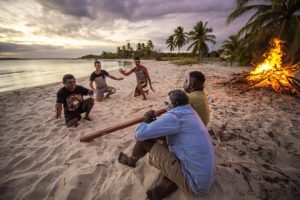Evening the playing field: Australia’s Solutions for Aboriginal Healthcare

In 2017, Australia’s medical system was ranked 2nd globally by The Commonwealth Fund. The country scored well on care, efficiency and health outcomes. However, the Australian health care system scored poorly on equity of care across the population. Those largely affected by the healthcare discrepancy are members of the indigenous community. Australia is working to decrease the inequity in Aboriginal healthcare.
Health Challenges for the Aboriginal Healthcare
The average lifespan for indigenous Australians is about 71.4 years, which is 10 years lower than the life expectancy of non-indigenous Australians. About two-thirds of the indigenous population die before the age of 65. Only 19% of non-indigenous people die before 65. Indigenous children under the age of four are also twice as likely to die than non-indigenous children. The common issue of chronic disease is a burden across all age groups of the indigenous population. Indigenous peoples are also over twice as likely to struggle with issues such as addiction and diabetes.
The National Aboriginal Community Controlled Health Organisation (NACCHO) reports that the problems facing the Aboriginal healthcare system come from five major health concerns. These five health factors are injury, mental disorders (including substance abuse), cardiovascular disease, respiratory diseases and cancer. Many of these major health concerns are considered to be preventable.
Another discrepancy in Aboriginal healthcare is access to maternal health services. In 2016, 40% of indigenous women lived in very remote areas of Australia, where the access to hospitals equipped with a birthing ward is very low. Women were forced to travel long distances in order to access birthing services. The Australian Institute of Health and Welfare cites that access to “culturally appropriate” care is a major barrier to women seeking maternal services. However, the Australian government has taken a new approach to bring healthcare to indigenous Australians.
The Aboriginal Community Controlled Health Services Initiative (ACCHS)
In Australia, healthcare centers operated by the local indigenous community have shown success in providing medical services to the Aboriginal population. ACCHS aims to provide healthcare to indigenous communities in a way that fosters ongoing medical relationships. These relationships between Aboriginal healthcare providers and the Aboriginal community have been 23% more effective in retaining patients when compared to other healthcare centers. NACCHO believes that a major factor in patient retention is that ACCH centers provide a sense of “cultural safety” within its healthcare practices.
In 1970, the first ACCHS was established and, as of the year 2020, over 140 ACCHS centers are now being operated around Australia. ACCHS centers currently address 61% of the healthcare demands of patients in regional communities. The use of ACCHS centers is continuously growing within the Aboriginal population, demonstrating the success of the initiative. Over a span of 24 months, the NACCHO reported an increase of 24,030 patients.
The Future of ACCHS and Indigenous Communities
The ACCHS initiative also provides opportunities for regional and remote Aboriginals to gain entry into the healthcare profession. The census in 2006 reported that 99% of healthcare workers out of all of the Australian medical workers are not of indigenous descent. Over half of ACCHS workers are indigenous, however, many of these workers are non-clinical staff members. NACCHO strives to create pathways for Aboriginal health care workers through the ACCHS centers. These pathways will allow indigenous community members to operate ACCHS centers, potentially increasing the relationship between patients and healthcare providers.
The Australian government has developed Closing the Gap targets to help decrease the discrepancy of healthcare between indigenous and non-indigenous Australians. The target states that Australia should have equity in Aboriginal healthcare by 2031. The NACCHO and the ACCHS centers are a key factor for Australia to reach the Closing the Gap targets.
– Laura Embry
Photo: Flickr
